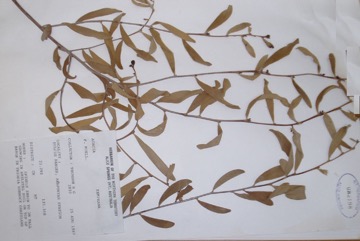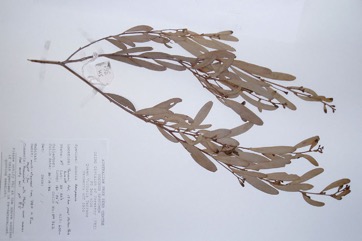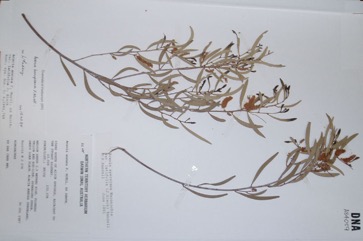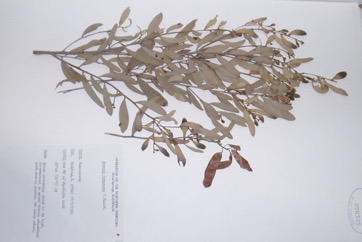Witchetty bush, Kemp’s Wattle

It is widespread in central Australia. It requires well drained soil. It can grow in part or full sunlight. It can withstand some drought and frost and grows in semi arid areas. It is often in limestone areas. Hot fires can kill it but it can re-shoot after cool fires in winter. It can grow in arid places.
Also known as:
Atnyima, Ngarlkirdi, Yiripili
Synonyms
- Acacia sibirica
Edible Portion
- Seeds, Gum, Honeydew, Grub, Leaves
Where does Witchetty bush grow?
Found in: Australia
Notes: There are about 1,350 Acacia species. Over 1,000 occur in Australia. Also as Mimosaceae.
Growing Witchetty bush, Kemp’s Wattle
Cultivation: It is grown from seed. The seed needs treatment to break the hard seed coat. Normally this is by putting the seeds in very hot water and letting the water cool down overnight then planting the seeds immediately.
Edible Uses: The seed are eaten. The tree harbours a large tasty grub which is eaten. Grubs can be 11.5 g weight. The grubs can be eaten raw or lightly roasted. They are good protein. The Red Lerp scale produces a honey dew which is eaten. It also has edible gum.
Production: Plants flower and seed well only after reasonable rains. The trees look more green at these times.
Nutrition Info
per 100g edible portion| Edible Part | Energy (kcal) | Protein (g) | Iron (mg) | Vitamin A (ug) | Vitamin c (mg) | Zinc (mg) | % Water |
|---|---|---|---|---|---|---|---|
| Seed | 293 | 24 | 3.8 | - | - | 3.3 | 4.5 |
| Gum | - | - | - | - | - | - | |
| Honeydew | - | - | - | - | - | - |
Witchetty bush, Kemp’s Wattle Photos




References
Bodkin, F., 1991, Encyclopedia Botanica. Cornstalk publishing, p 22
Bonney, N., 1997, Economic Native Trees and Shrubs for South Australia. Greening Australia (SA) inc. Campbelltown SA 5074 p 7
Cancilla, D., 2018, Ethnobotanical and Ethnozoological Values Desktop Assessment - Eliwana Project. p 9
Chem. & Druggist (Australas.) suppl. 5:26. 1882
Cherikoff V. & Isaacs, J., The Bush Food Handbook. How to gather, grow, process and cook Australian Wild Foods. Ti Tree Press, Australia p 42, 188
Elliot, W.R., & Jones, D.L., 1982, Encyclopedia of Australian Plants suitable for cultivation. Vol 2. Lothian. p 70
Goddard, C. & Kalotas A. (Eds.), Punu, 2002, Yankunytjatjara plant use. Jukurrpa books. p 44
Hall, N. et al, 1972, The Use of Trees and Shrubs in the Dry Country of Australia, AGPS, Canberra. p 348
Hiddins, L., 1999, Explore Wild Australia with the Bush Tucker Man. Penguin Books/ABC Books. p 168
Isaacs, J., 1987, Bush Food, Aboriginal Food and Herbal Medicine. Weldons. p 107, 110, 112
Latz, P & Wightman, G., 1995, Desert Bush Tucker Identikit. Common Native Food Plants of Central Australia. Parks & Wild Commission Northern territory. p 22
Lazarides, M. & Hince, B., 1993, Handbook of Economic Plants of Australia, CSIRO. p 4
Lister, P.R., P. Holford, T. Haigh, and D.A. Morrison, 1996, Acacia in Australia: Ethnobotany and potential food crop. p. 228-236. In: J. Janick (ed.), Progress in new crops. ASHS Press, Alexandria, VA.
Low, T., 1991, Wild Food Plants of Australia. Australian Nature FieldGuide, Angus & Robertson. p 179
Miers, G., 2004, Cultivation and sustainable wild harvest of Bushfoods by Aboriginal Communities in Central Australia. RIRDC report W03/124 p 19
Paczkowska, G . & Chapman, A.R., 2000, The Western Australian Flora. A Descriptive Catalogue. Western Australian Herbarium. p 312
Pennock, A., et al, Australian Dry-zone Acacias for Human Food: Proceedings of a Workshop.
Smith, K & I., 1999, Grow your own bushfoods. New Holland. Australia. p 101
Urban, A., 1990, Wildflowers of Inland Australia. Portside editions. p 84